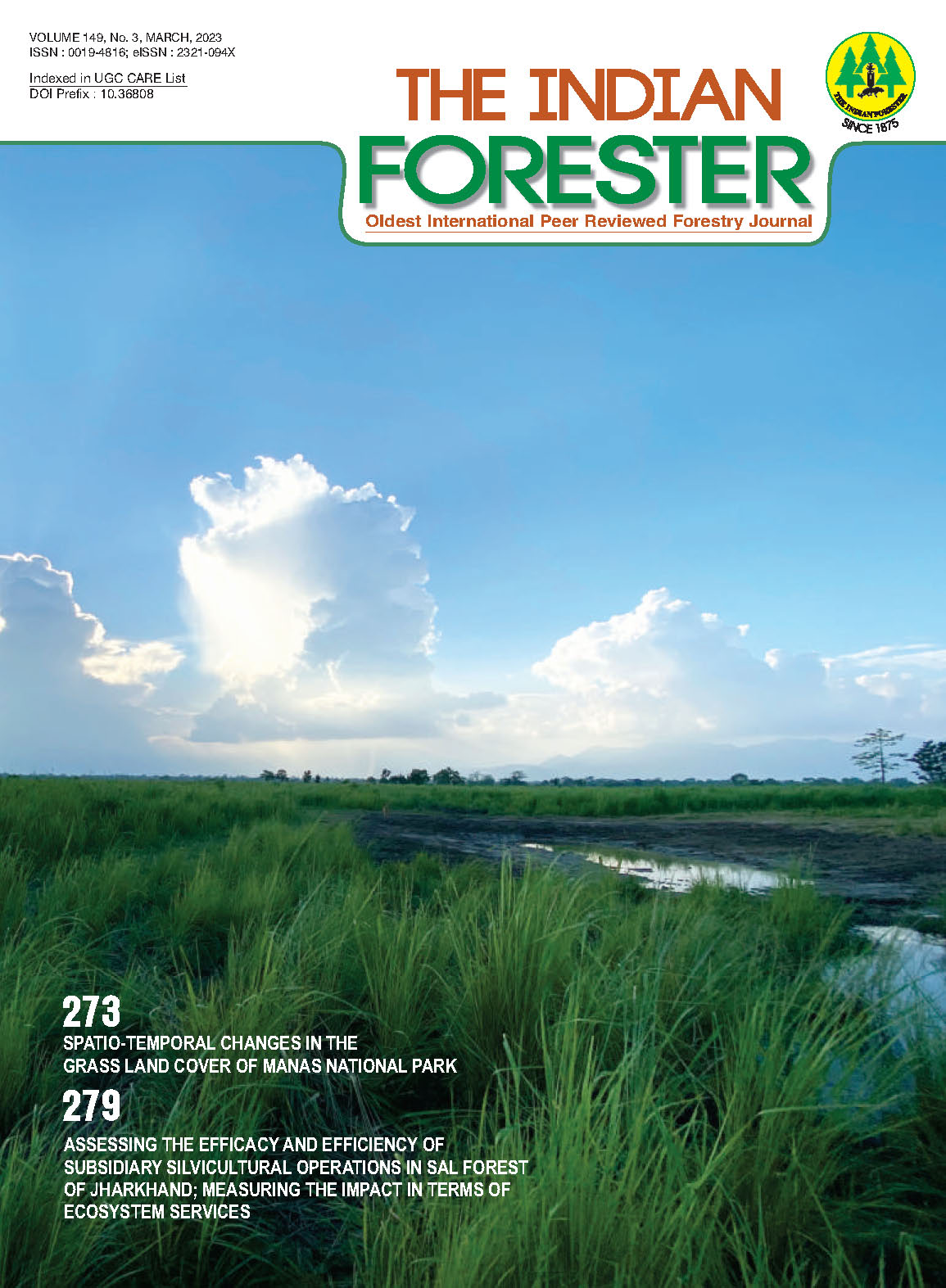The Seed Morphology and Germination Behavior of Sesbania grandiflora L. Under Nursery Conditions
DOI:
https://doi.org/10.36808/if/2023/v149i3/168170Keywords:
Germination Behaviour, Nursery, Mean Germination Time, Germination Energy.Abstract
The present research attempts to characterize the morphological and germination behavior of a promising fodder species Sesbania grandiflora L. (Agast) under nursery conditions. Experiment was carried out at the nursery of the Forest Research Center for Eco-Rehabilitation (FRCER), Prayagraj, Uttar Pradesh, during April 2021 and different germination parameters viz, germination per cent, survival per cent, germination capacity, germination energy, vigour index, mean daily germination and mean germination time along with seed morphological parameters were studied. Early germination from the medium-sized seeds of S. grandiflora proved to be significant under nursery conditions. A good germination per cent (83.42%) and low mean germination time (14.19 days) indicates an early and rapid germination of S. grandiflora under nursery conditions. Such an investigation may help nursery managers to produce seedlings of species for fodder availability during lean period.References
Abdul-Baki A.A. and Anderson J.D. (1973). Vigour determination in soyabean by multiple criteria. Crop Sci., 13: 630-633.
Ahirwar J.R. (2012). Effect of seed size and weight on seed germination of Alangium lamarckii, Akola, India. Research Journal of Recent Sciences, 1 (ISC-2011): 320-322.
Bewley J.D. and Black M. (1978). The Physiology and Biochemistry of Seeds, Berlin, Springer-Verlag, 1: 306.
Chanda S.C., Mridul A.M., Sagar A. and Sarwar A.K.M.G. (2017). Germination and seedling growth of Sesbania species as influenced by seed size. Progressive Agriculture, 28(4): 316-322.
Duke J.A. (1961). Preliminary revision of the genus Drymaria. Ann. Missouri Bot. Gard., 48: 173 - 268.
Edwards C.J. Jr. and Hartwig E.E. (1971). Effect of seed size upon rate of germination in soybeans. Agron. J., 63: 429-430.
Ellis R.H. and Robert E.H. (1981). The Quantification of aging and survival in orthodox seeds. Seed Science and Technology, 9: 373-409.
Gardner F.P., Pearce B.R. and Mitchell R.L. (1985). Physiology of Crop Plants. Iowa State Univ. Press, Ames. p. 209-245
Geneve R.L. (2008). Vigor testing in small-seeded horticultural crops. Acta Hort., 782: 77-82.
Girish B., Shahapurmath G.R., Kumar A.K.K. and Ganiger B.S. (2001).Effect of seed size and depth of sowing on seed germination in Sapindus trifoliatus. My Forest, 37: 483-489.
ISTA (1999). International rules for seed testing. Seed Sci. and Tech., 27: 27-31.
Karki H., Bargali K., Bargali S.S. and Vibhuti (2018). Seed size variation in Quercus floribunda Lindl. and its effect on germination and seedling growth. Current Trends Forest Research CTFR-107.
Kumar H., Lal S.B., Wani A.M., Umrao R., Khare N. and Kerketta N.S. (2017). Seed Size Correlates with Germination Traits in Terminalia arjuna Genotypes. Int. J. Curr. Microbiol. App. Sci, 6(8): 2896-2903.
Nikolaeva M.G. (1958). Biology of germination of tree (Fraxinus) seeds and its bearing on the taxonomic position and distribution. Botani Scheskm Moscow, 43: 673 - 683.
Pandey R., Pandey D.K, Singh N.K., Mishra R.P. and Joshi B.W. (2003). Genotypic variability in seed andseedling growth in Sesbania species. Indian J. Plant Physiol., 8: 270-276.
Rezapour R., Kazemi-arbat H., Yarnia M. and Zafarani- Moattar P. (2013). Effect of seed size ongermination and seed vigor of two soybean (Glycine max L.) cultivars. Int. Res. J. Appl. Basic Sci., 4: 3396-3401.
Scott S., R. Jones and W. Williams (1984). Review of data analysis methods for seed germination. Crop Science, 24: 1192–1199.
Singh R.V. (1986). Social Forestry for fodder production. 4th Seth memorial lecture, Dehradun. FRI.
Uniyal A.K., Singh B. and Todaria N.P. (2007). Effects of seed size, sowing orientation and depth on germination and seedling growth in Neem, Azadirachta indica. Seed Technology, 68-75.
Wang B.S.P., Pitel A. and Webb D.P. (1982). Environmental and genetic factors affecting tree and shrub seeds. In: Advances in Research and Technology of Seeds. (Ed. J.R. Thomson). Part 7, Centre for Agriculture Publishing and Documentation, Wageningen, Netherlands, pp. 87-135.
Downloads
Downloads
Published
How to Cite
Issue
Section
License
Unless otherwise stated, copyright or similar rights in all materials presented on the site, including graphical images, are owned by Indian Forester.





